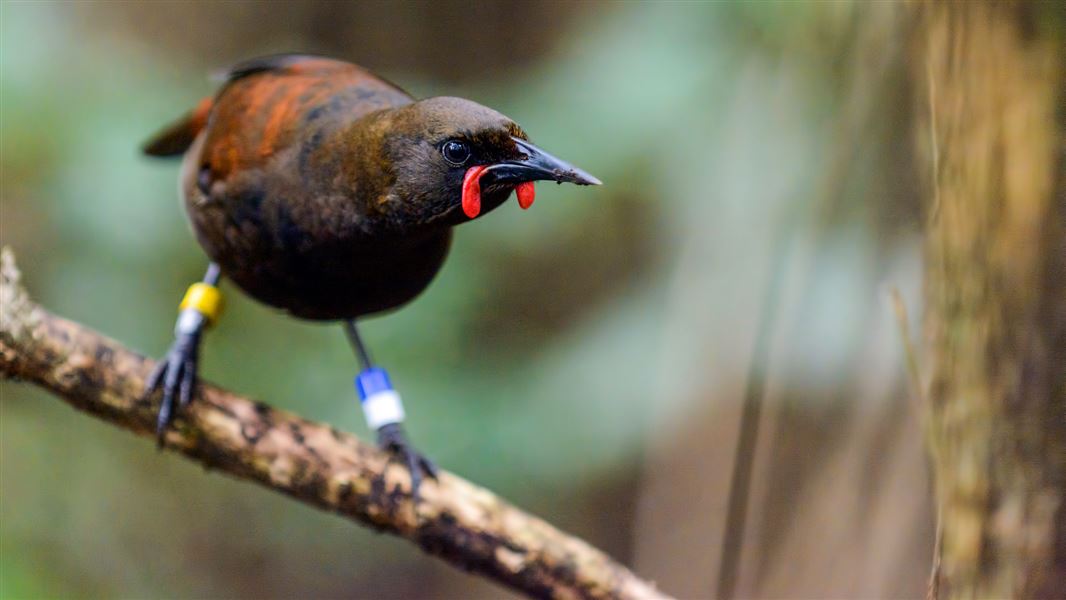First determine your habitat connectivity, habitat size and predator control levels of the translocation site; then view the predicted success of translocations for different scenarios.
Points to note if you are translocating this species
North Island saddlebacks are extremely vulnerable to all predators except mice and kiore. Therefore, all mammalian predators must be eradicated or maintained at zero density at your release site.
This species requires high-quality coastal and inland forests, including scrubby regenerating areas.
Saddlebacks roost and nest in cavities, and can use artificial roosts and nest boxes.
Most populations have been through serial translocations so you should carefully consider whether multiple source locations could be used for the founders to increase the genetic diversity of your translocated population (see Fig. 2).
Factors of success for North Island saddleback
Founder number for maximising genetic diversity
40 – consider using multiple source locations to maximise the genetic diversity of founders
Habitat connectivity
Low (isolated)
Dispersal is likely to be low in habitats with low connectivity. North Island saddlebacks are unlikely to disperse across open areas or water gaps > 250 m.
Medium
North Island saddlebacks will fly up to 250 m over areas of unsuitable habitat, so you can expect low levels of dispersal – but not enough to affect population viability. For example, North Island saddleback populations have successfully established at Zealandia and Tawharanui Regional Park despite low levels of dispersal.
High (adjoining)
Dispersal is likely to be high in adjoining habitats. If there are no large areas of unsuitable habitat to cross, some saddlebacks will inevitably disperse and be lost from the population.
Habitat size
Small (minimum area)
80 ha (assuming it is of very high quality) – translocations to islands < 100 ha have had low success
Medium
> 100 ha
Large
≥ 200 ha
Minimum predator control
If you are translocating North Island saddlebacks, all mammalian predators except mice and kiore will need to have been eradicated from your release site or be permanently maintained at zero density.
Predators maintained at low density
North Island saddlebacks cannot be translocated to sites where predators are maintained at low density as populations will quickly go extinct in the presence of mammalian predators.
Predators eradicated
This requires the total eradication of all target predators with the exception (in most cases) of mice and kiore, or the maintenance of zero density year-round.
Predicted success for scenarios
North Island saddleback: Scenario 1
Scenario: Low habitat connectivity, small habitat size, predators eradicated.
Data source: This projection used island productivity and survival data averaged from Tiritiri Matangi Island and Mokoia Island.
Conditions: 40 birds were translocated in year one; the carrying capacity of the site was 200 saddlebacks; there was no migration.
Outcome: A viable population will likely establish, but some genetic diversity will be lost over ten generations, which may affect the long-term persistence of the population. You could improve this result by choosing a larger site (see Scenario 2).
North Island saddleback: Scenario 2
Scenario: Low habitat connectivity, medium habitat size, predators eradicated.
Data source: This projection used mainland productivity and survival data from Bushy Park.
Conditions: 40 birds were translocated in year one; the carrying capacity of the site was 500 saddlebacks; there was no migration.
Outcome: A viable population will likely establish and 80–90% of genetic diversity will be maintained over ten generations.
North Island saddleback: Scenario 3
Scenario: Low habitat connectivity, large habitat size, predators eradicated.
Data source: This projection used island productivity and survival data averaged from Tiritiri Matangi Island and Mokoia Island.
Conditions: 40 birds were translocated in year one; the carrying capacity of the site was 1000 saddlebacks; there was no migration.
Outcome: A viable population will likely establish and 80–90% of genetic diversity will be maintained over ten generations.
North Island saddleback: Scenario 4
Scenario: Medium habitat connectivity, small habitat size, predators eradicated.
Data source: This projection used mainland productivity and survival data from Bushy Park.
Conditions: 40 birds were translocated in year one; the carrying capacity of the site was 200 saddlebacks; there was no migration.
Outcome: A viable population will likely establish, but some genetic diversity will be lost over ten generations. You could improve this result by choosing a larger site with low connectivity (see Scenarios 2 and 3).
North Island saddleback: Scenario 5
Scenario: High habitat connectivity, large habitat size, predators eradicated inside a smaller fenced area.
Data source: No data were available for this scenario so values were estimated by an expert – therefore, there is no certainty in the results. Productivity and survival data were averaged from Tiritiri Matangi Island and Mokoia Island, and initial survival was set at 0.5 (due to high dispersal) to simulate adjoining habitat.
Conditions: 100 birds were translocated in year one; the carrying capacity of the site was 1000 saddlebacks; there was no migration.
Outcome: There is uncertainty about whether saddlebacks would successfully establish in highly connected sites as dispersal could lead to population extinction (despite the apparent success shown on the graphs below) depending on the contrast and extent of the habitat inside vs. outside the fence – in most cases, the habitat inside the fence would need to be higher quality than the habitat outside the fence. If successful, population establishment would be slow but a viable population might establish and 80% of genetic diversity could be maintained over ten generations. You could improve this result by choosing a low-connectivity site, which would increase the rate of population growth and the genetic diversity (see Scenarios 2 and 3).





